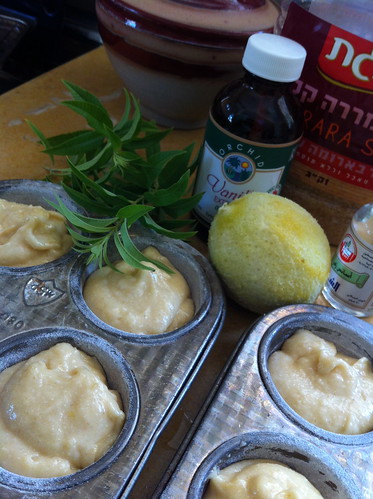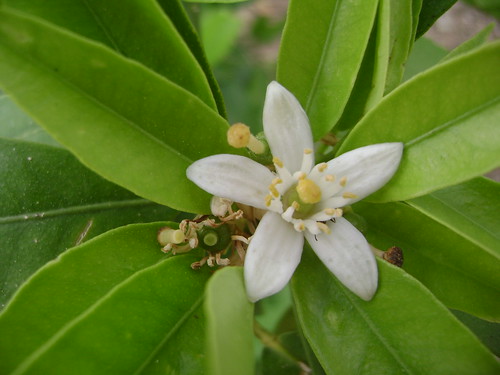
Common knowledge is not always correct, and the main reason this happens with perfumery’s building block is simple: the widespread use of synonyms and various traditional names for particular oils rather than using the more accurate and reliable Latin name of the species of origin.
It is therefore not so surprising that bit by bit, many perfume aficionado as well as amateur DIY perfumers were lead to believe that it is the
bergamot (Citrus aurantium var. bergamia) tree that provides the perfumer with the generous palette of oils of bergamot, petitgrain, neroli and orange flower absolute.
This is, however, very wrong! The Giving Tree Medal should be awarded to the
Bitter Orange Tree (Citrus aurantium var. amara). Ther names for the bitter orange tree are Seville orange, sour orange and bigarade orange.
This citrus subspecies is very resilient of disease and therefore is used for grafting other citrus subspecies (i.e. sweet oranges). It bears very sour and bitter fruit that is inedible for the most part (except for use in marmalades, because of its high pectin content).
Despite its very limited culinary use, bitter orange is held in high regards from an olfactory point of view, supplying the perfumer’s organ with a few priceless essences:
1) The unusually floral, sparkling bitter orange oil from the fruit’s peel, which has a dry, bitter aroma with sweet undertones. It has excellent uplifting qualities and blends beautifully with forals, showcasing their beauty like no other citrus does. This oil is expressed from the peel (though in some countries, after the expression the peel will be submitted to further extraction by steam distillation, which provides a very poor oil, often mixed with the expressed bitter orange oil to adulterate it).
2) The middle note of petitgrain bigarade, steam distilled from the leaves and twigs of the tree after they are pruned. This is a fresh, dry, aromatic, astringent green-leafy yet citrus note, most prized for its astringent presence in colognes and aftershaves. Other petitgrain essential oils are available in far lesser quantities, such as: petitgrain lemon, petitgrain combarva (from the kaffir lime tree) and petitgrain cedrat. The majority of petitgrain oils available though are from the bitter orange tree.
3) Orange flower absolute – produced by solvent extraction from the same flowers of bitter orange. This produces an essence that is a base to middle note, and is very deep, rich, honeyed quality. It shares some similarities to the more indolic jasmine absolute, yet with a very distinct citrus tartness. A complex building block that is valued for its balance between sweet and tart, floral and fresh. It is used in colognes and many men’s fragrances to add a warm yet fresh body to the fragrance. It is also used in many floral bouquets and oriental compositions, adding a sensual complexity and vivacity.
4) The heart to top note of neroli – this is the steam distilled essential oil from the flowers of the tree. Neroli essential oil is one of the most expensive essential oils. It was named after the princess of neroli, who favoured this scent like no other, and used it to scent herself and all her belongings. Neroli essential oil has unique calming effect on the mind, and was therefore used to reduce the anxiety of (virgin) brides (it is also traditionally used in bridal bouquets). Neroli has a sweet yet clean and dry ethereal quality, it’s very delicate and light. It is often used in colognes as well as floral composition to add a light floral lift.
5) Orange flower water is a by product of the neroli production: some of the aromatic elements of neroli are water soluble, and therefore stay in the water in the process fo distillation. The same process happened with the steam distillation of roses, which in turn provides us with rose water. Orange flower water is used mostly in food (to flavour sweets and baked goods, particularly in the Middle East, Mediterranean region and India) cosmetics (it makes a fantastic gentle tonic on its own, for oily skin or acne prone skin, yet without causing any harm or drying; it is also used as a base in lotions and other cosmetic preparations). It can be also used to top off various Eaux (Eau Fraiche, Eau de Cologne and Eau de Toilette), and can be used as a fragrance on its own in warm weather.
Click here for an excellent recipe for the Basbousa cake – a semolina cake made with yoghurt and an orange flower water flvaoured honey-syrup.
6) Orange flower water absolute is a further process of the orange blossom water. It is similar to orange flower absolute, but is more sheer, honeyed and somehow smells watery as well. It is used as a heart note.

Bergamot orange, on the other hand, provides us only with the oil of the fruits’ peel, which has the disctinct bergamot aroma – green, floral, peculiar yet citrusy, and very heady. It is used extensively in flavouring the Earl Grey tea, and that’s how bergamot is most known to the public. It is also used in Italy and Greece in certain marmalades and candied, but this is not very common.
Images are courtesy of
Wikipedia.





